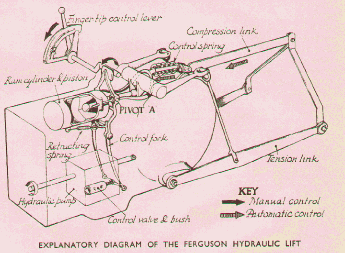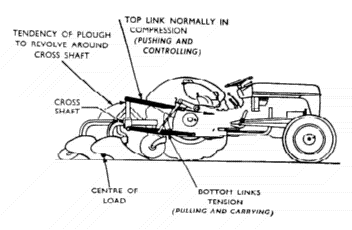
Ferguson
System Principal and Theory of Operation
|
|
Ferguson System
An implement cutting through the soil at a certain depth say eight inches requires a certain force or draft to pull it. Obviously that draft will increase if the implement runs deeper than eight inches, and decrease if it runs shallower. Why not use that draft fact to control the depth of work automatically? The draft forces are sensed through the points of attachment and the hydraulic pump automatically reacts to changes in draft loading. So if our implement cutting at eight inches is forced deeper into the soil. By the front end of the tractor rising upwards over a small hill, the immediate increase in draft would give a lift signal to the hydraulic pump and the implement would be raised to such a point as the draft forces were equal to previous. ie eight inches. Conversely if the front end of the tractor drops in a hole, the implement depth raises to say six inches the draft force would reduce and this would then send a drop signal to the hydraulic controls thus the implement would dig deeper and the draft forces would balance again at the eight inches. This principal is known as Draft control and was patented by Harry Ferguson June 1926. The Ferguson design team worked on this principal for quite some time using springs and levers and other mechanical ideas and eventually Hydraulics was seen as the solution to this problem.
The Ferguson System of Implement Linkage and Hydraulic on the TE Tractors utilizes the above basic principle in the application and control of power to farm implements. The Ferguson System utilizes three points of attachment, instead of one, to transmit the pulling force of the tractor to the drawn implement. The implement is attached to the tractor by means of two bottom links which PULL the implement, and a top link which PUSHES FORWARD AND DOWNWARD ON THE TRACTOR ABOVE THE REAR AXLE. Thus the weight of the implement and resistance of the soil to the implement plus the effect of other forces adds traction-producing weight as needed. The forward thrust through the top link also keeps front end of the tractor down even up steep hills.
The compression force exerted through a spring in the top link also acts on the built-in hydraulic system to govern soil depth of the implement automatically(draft control). Manual changes in depth are made by the Finger Tip Control Lever within easy reach of the driver's seat.
The Ferguson system also has one very important safety feature which no other Tractor not using the Ferguson system of control had at the time. This is a safety relief control. If while plowing the implement was to strike a solid object, ie large rock or tree root the hydraulic pressure is released, the weight transfer to the rear wheels is immediately reduced to such an extent that the weight of the tractor is actually supported by the implement. Thus leaving the back wheels to harmlessly spin. This prevents damage to implement and tractor and reducing the risk of rear roll over that a lot of tractors at the time suffered from so badly.
|
|
Ferguson
System












